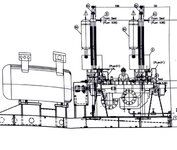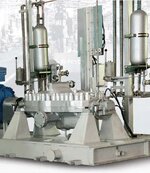Newpumptech
Mechanical
- Jan 1, 2025
- 19
We are experiencing severe vibrations and operational issues with two identical API 610 six-stage centrifugal pumps (6"x6) that were originally designed for crude oil service. We are now using these pumps in different locations to pump saltwater, and the performance has been significantly worse than expected.
Pump Details:
* API 610, 6-stage, 6"x6
* Original design: Crude oil (density 900 kg/m³, temperature 60°C, viscosity 13.2 cSt)
* Design head: 380m
* Design flow: 100 m³/h
* Speed: 2950 RPM
* Impeller: Six vanes
* Diffuser: Six vanes, enclosed type
* Casing: Diffusers separated from upper casing
* Bearings: Dual 7311BECBJ (non-drive end), 6213J (drive end)
* Material: Duplex stainless steel
* Minimum stable flow: 30 m³/h
* NPSHr at rated flow: 2.35 m
Current Operation (Saltwater):
* Fluid: Saltwater (100 g salt per liter)
* Current flow: Reduced to 13 m³/h to control vibrations and amperage
* Symptoms:
* High vibrations, particularly at the non-drive end
* Vibrations felt in the ground around the pump
* Pressure pulsations in suction and discharge (approx. 20%)
* High noise levels with a harmonic rhythm
My colleagues believe the pump's issues stem from it being designed for crude oil rather than saltwater. However, I'm confident that the pump's materials and design are suitable for saltwater. I'm looking for a clear plan of action to address these problems and prevent further damage. Could you provide guidance on where to start and any insights into the potential root causes?
Pump Details:
* API 610, 6-stage, 6"x6
* Original design: Crude oil (density 900 kg/m³, temperature 60°C, viscosity 13.2 cSt)
* Design head: 380m
* Design flow: 100 m³/h
* Speed: 2950 RPM
* Impeller: Six vanes
* Diffuser: Six vanes, enclosed type
* Casing: Diffusers separated from upper casing
* Bearings: Dual 7311BECBJ (non-drive end), 6213J (drive end)
* Material: Duplex stainless steel
* Minimum stable flow: 30 m³/h
* NPSHr at rated flow: 2.35 m
Current Operation (Saltwater):
* Fluid: Saltwater (100 g salt per liter)
* Current flow: Reduced to 13 m³/h to control vibrations and amperage
* Symptoms:
* High vibrations, particularly at the non-drive end
* Vibrations felt in the ground around the pump
* Pressure pulsations in suction and discharge (approx. 20%)
* High noise levels with a harmonic rhythm
My colleagues believe the pump's issues stem from it being designed for crude oil rather than saltwater. However, I'm confident that the pump's materials and design are suitable for saltwater. I'm looking for a clear plan of action to address these problems and prevent further damage. Could you provide guidance on where to start and any insights into the potential root causes?


